Understanding Media Converters
Media converters play a vital role in modern networking by facilitating the seamless transmission of data between disparate network infrastructures. In this article, we delve into the fundamental concepts surrounding media converters, exploring their functions, applications, and the distinctions between managed and unmanaged variants. Through a comparative analysis, we aim to provide insights into their respective advantages, disadvantages, and suitability across various industries.
Definition and Function of Media Converters
Media converters serve as intermediary devices that convert signals fr om one media type to another, enabling compatibility between different network technologies. They bridge the gap between copper and fiber optic cabling, extending network reach and flexibility. Their primary function involves converting Ethernet signals between copper twisted-pair and fiber optic cables, but they can also support other interfaces such as serial ports, audio/video signals, and TDM protocols.
Applications of Media Converters
The versatility of media converters makes them indispensable across a wide range of industries and applications. They are commonly deployed in telecommunications, industrial automation, transportation, and surveillance systems wh ere the integration of diverse network technologies is essential for seamless communication.
Distinctions between Managed and Unmanaged Media Converters:
Unmanaged Media Converters:
- Basic operation with no user configuration required.
- Plug-and-play functionality for straightforward deployment.
- Suited for simple network expansion and connectivity enhancement.
- Cost-effective solution for small to medium-sized networks.
- Limited management capabilities and monitoring features.
An example of an unmanaged media converter is the "RUGGEDCOM-RMC41"
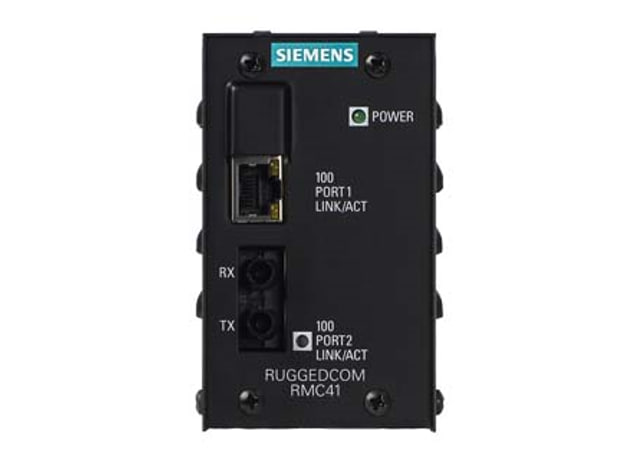
Functionality and Features:
- Serial-to-Fiber Conversion: Converts serial communication signals (RS-232/RS-422/RS-485) to fiber optic signals, extending the reach of communication networks.
- Industrial Design: Built to withstand extreme environmental conditions including temperature variations, humidity, electrical noise, and mechanical stresses.
- Multiple Serial Ports: Typically equipped with multiple serial ports to accommodate various serial communication protocols.
- Fiber Optic Connectivity: Offers robust fiber optic connectivity for long-distance communication with high reliability and noise immunity.
- Remote Management: Supports remote management capabilities, allowing for easy configuration and monitoring of the device fr om a central location.
- Advanced Diagnostics: Provides advanced diagnostic features to aid in troubleshooting and maintenance tasks.
- Wide Temperature Range: Operates within a wide temperature range, ensuring reliability even in extreme temperatures.
- DIN-Rail Mountable: Designed for easy installation on DIN rails commonly used in industrial environments.
Key Features Include:
- Robustness: Designed to withstand harsh industrial environments, including resistance to shock, vibration, and electromagnetic interference.
- Flexibility: Supports various serial communication standards and fiber optic interfaces, providing flexibility in deployment.
- Reliability: Built with high-quality components and redundant features to ensure reliable operation even in challenging conditions.
- Security: Offers features to enhance the security of industrial networks, such as access controls and encryption protocols.
Advantages:
- Robustness: Designed to withstand harsh industrial environments, including resistance to shock, vibration, and electromagnetic interference.
- Flexibility: Supports various serial communication standards and fiber optic interfaces, providing flexibility in deployment.
- Reliability: Built with high-quality components and redundant features to ensure reliable operation even in challenging conditions.
- Security: Offers features to enhance the security of industrial networks, such as access controls and encryption protocols.
Applications:
- Industrial Automation: Used in industrial automation applications such as manufacturing plants, power generation facilities, and transportation systems.
- Utilities: Deployed in utility infrastructures including oil and gas facilities, water treatment plants, and electrical substations.
- Transportation: Applied in transportation systems such as railways, airports, and seaports for communication and control purposes.
- Renewable Energy: Utilized in renewable energy installations such as wind farms and solar power plants for monitoring and control of equipment.
- Telecommunications: Employed in telecommunications networks, particularly in remote or harsh environments wh ere standard equipment may be unsuitable.
In summary, RUGGEDCOM RMC41 offers robust serial-to-fiber conversion capabilities tailored for industrial applications, providing reliability, flexibility, and enhanced performance in harsh environmental conditions."
The second one of an unmanaged media converter is the " Industrial 10/100 Base-TX to 100 Base-FX Media Converter (Multimode, SC connector)"
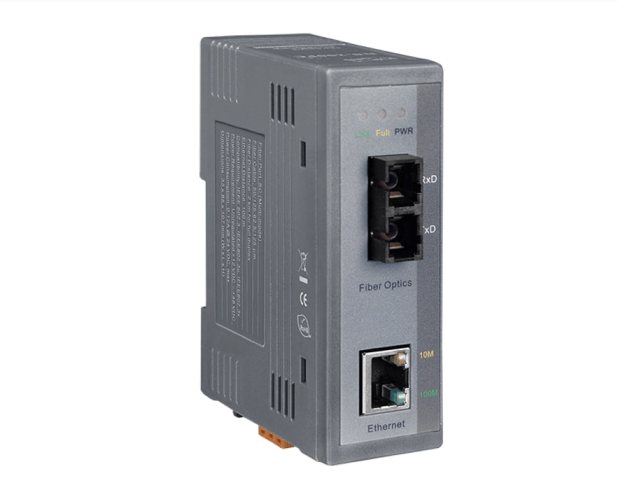
Industrial 10/100 Base-TX to 100 Base-FX Media Converter (Multimode, SC connector)
This industrial media converter is most likely an unmanaged device, meaning it operates with plug-and-play functionality and requires no configuration. Here's a breakdown of its functionalities, features, advantages, and applications:
Functionalities:
- Converts electrical signals fr om 10/100 Mbps Ethernet (Base-TX) twisted-pair copper cables to optical signals for 100 Mbps Ethernet (Base-FX) over multimode fiber optic cables with SC connectors.
- Extends the reach of your Ethernet network beyond the typical 100-meter limitation of copper cables, reaching distances up to 2 kilometers with multimode fiber.
Key Features:
- Unmanaged: Easy to use, no configuration required.
- Industrial grade: Designed for harsh environments with wider operating temperature ranges compared to commercial converters, typically -40°C to +75°C.
- Auto-negotiation: Automatically detects and adjusts for network speed (10 or 100 Mbps) and link type (full or half duplex) on both copper and fiber ports./li>
- Auto-MDI/MDIX: Eliminates the need for dedicated crossover cables by automatically detecting the cable type (straight-through or crossover) connected to each port.
- Multimode fiber support: Utilizes cost-effective multimode fiber optic cables for shorter-distance applications.
- SC connectors: Uses a common and readily available SC connector type for fiber optic connections.
Advantages:
- Extends network reach: Enables connections over longer distances compared to copper cables.
- Reliable and stable connection: Fiber optic cables are less susceptible to electromagnetic interference and signal degradation, ensuring a more reliable and stable connection in harsh industrial environments.
- Easy to use: Plug-and-play functionality makes it simple to deploy without configuration./li>
- Industrial grade: Built to withstand harsher environmental conditions.
Applications:
- Industrial automation: Connecting factory machines, sensors, and control systems across large facilities.
- Building automation: Establishing network connections between building management systems and various equipment throughout a building complex.
- Security and surveillance: Connecting security cameras and other network devices in widespread surveillance systems./li>
- Oil and gas: Connecting control systems and equipment in oil and gas refineries or pipelines.
- Transportation: Connecting network devices in transportation systems such as intelligent traffic control systems or railway signaling systems.
Additional Considerations:
- While this converter extends your network reach, ensure your overall network design considers factors like bandwidth requirements, latency, and future scalability when choosing the most suitable solution.
- For applications requiring advanced features like remote management, configuration options, or Layer 2 switching capabilities, consider managed media converters.
The second one of an unmanaged media converter is the " KOM600G 2G port DIN-Rail LFP copper to fiber media converters"
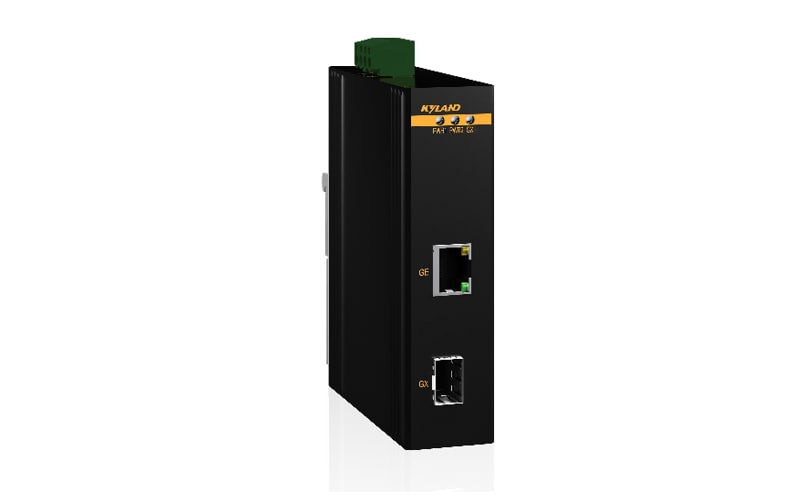
Kyland KOM600G: Functionality, Features, Advantages, and Applications
The Kyland KOM600G is an unmanaged 2-port DIN-Rail LFP copper to fiber media converter. This means it offers a simple solution for extending your network reach without requiring complex configuration. Here's a breakdown of its functionalities, features, advantages, and applications:
Functionality:
- Converts electrical signals fr om 10/100/1000 Mbps Ethernet (Base-T) twisted-pair copper cables to optical signals for 1000 Mbps Ethernet (Base-X SFP) over fiber optic cables using SFP modules (sold separately).
- Extends the reach of your Gigabit Ethernet network beyond the typical 100-meter limitation of copper cables, enabling connections over longer distances depending on the specific SFP module used.
Key Features:
- Unmanaged: Easy to use, plug-and-play functionality, no configuration required.
- Industrial grade: Designed for harsh environments with a wide operating temperature range (-40°C to +85°C), making it suitable for industrial applications.
- Auto-negotiation: Automatically detects and adjusts for network speed (10 or 100 Mbps) and link type (full or half duplex) on both copper and fiber ports./li>
- Auto-MDI/MDIX: Eliminates the need for dedicated crossover cables by automatically detecting the cable type (straight-through or crossover) connected to each port.
- DIN-Rail mountable: Enables easy installation in industrial control cabinets using standard DIN-rails.
- LFP (Low Power Consumption): Reduces energy consumption, making it an eco-friendly choice.
- 1 SFP slot: Supports various SFP modules for different fiber optic cable types and transmission distances (modules not included).
Advantages:
- Extends network reach: Enables connections over longer distances compared to copper cables, ideal for industrial applications wh ere devices might be spread out across large facilities.
- Reliable and stable connection: Fiber optic cables are less susceptible to electromagnetic interference and signal degradation, ensuring a more reliable and stable connection in harsh industrial environments.
- Easy to use: Plug-and-play functionality makes it simple to deploy without configuration./li>
- Industrial grade: Built to withstand harsher environmental conditions.
- Low power consumption: Reduces operational costs and environmental impact.
Applications:
- Industrial automation: Connecting factory machines, sensors, and control systems across large facilities.
- Building automation: Establishing network connections between building management systems and various equipment throughout a building complex.
- Security and surveillance: Connecting high-resolution security cameras and other network devices in widespread surveillance systems./li>
- Transportation: Connecting network devices in transportation systems such as intelligent traffic control systems or railway signaling systems.
- Oil and gas: Connecting control systems and equipment in oil and gas refineries or pipelines.
Additional Considerations:
- Remember to choose the appropriate SFP module based on your desired fiber optic cable type, transmission distance, and network requirements.
- While the KOM600G offers a cost-effective solution for basic media conversion, if you need advanced features like remote management, configuration options, or Layer 2 switching capabilities, consider managed media converters.
More details at
Managed Media Converters:
- Advanced features such as Ring Operation and Automatic Data Direction Control (ADDC®).
- Configuration options for optimizing network performance and resilience.
- Remote management capabilities for monitoring and troubleshooting.
- Higher upfront cost but offers greater flexibility and control.
- Ideal for complex network environments requiring proactive management and control.
An example of a managed media converter is the "GT-915A".
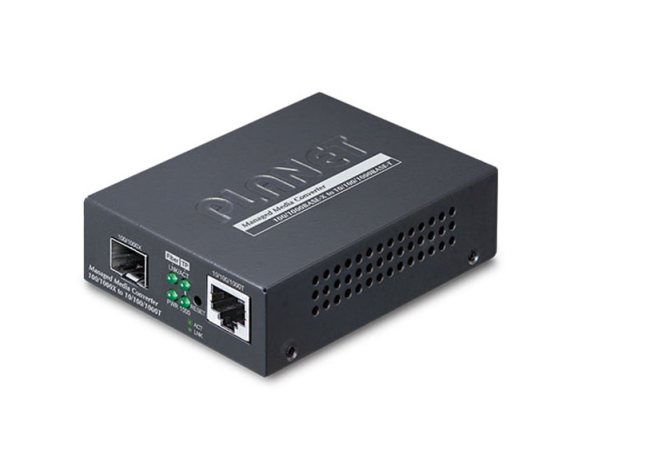
Remote Management: The GT-915A can be managed remotely via two methods:
- Simple Network Management Protocol (SNMP): This industry-standard protocol allows the device to be integrated into network management platforms for centralized monitoring and configuration.
- Web-based Interface: The device has a built-in web server that allows access to a user-friendly web interface for configuration and monitoring through a web browser.
Configuration Options: The web interface or SNMP allows configuration of various features, including:
- Port settings: Speed, duplex mode, flow control, etc.
- VLAN management: Creating and managing VLANs for network segmentation.
- Quality of Service (QoS): Setting priorities for different types of traffic to ensure the smooth operation of critical applications./li>
- Security features: Enabling/disabling ports, setting up port security, etc.
- Monitoring: Real-time monitoring of device status, SFP transceiver health, and network traffic.
Layer 2 Switching
The GT-915A functions as a Layer 2 switch, meaning it can forward data packets based on the MAC address (Media Access Control address) in the packet header. This allows it to
- Connect multiple devices: The GT-915A has two copper ports and one SFP fiber port, enabling connection to various devices like computers, switches, and other network equipment.
- Segment networks: By creating VLANs, the switch can logically separate network traffic, improving security and performance.
- Improve efficiency: By forwarding packets only to the intended recipient port, the switch reduces unnecessary traffic broadcast across the entire network./li>
Redundancy and Reliability
The GT-915A offers features to enhance network redundancy and reliability:
- Dual Power Input: The device accepts power fr om two separate sources, ensuring continued operation even if one power source fails.
- Loop Prevention: This feature automatically detects and prevents network loops, which can cause network instability and outages.
Security
The GT-915A incorporates several security features to protect your network:
- Port Security: This feature restricts unauthorized devices from accessing specific ports by limiting the number of MAC addresses allowed on each port.
- 802.1X Port-based Authentication: This protocol allows for secure device authentication using an external RADIUS server.
- VLANs: As mentioned earlier, VLANs can isolate network traffic, preventing unauthorized access to sensitive data on different segments./li>
Environmental Monitoring
The GT-915A can monitor various environmental factors that can impact its performance and longevity:
- Temperature: The device can monitor its internal temperature and raise alerts if it exceeds safe operating levels.
- Voltage: It can also monitor the voltage levels of its power supplies and notify administrators of potential power issues. Comparative Analysis:
The second example of a managed media converter is the " IMC-1000WS-PB"
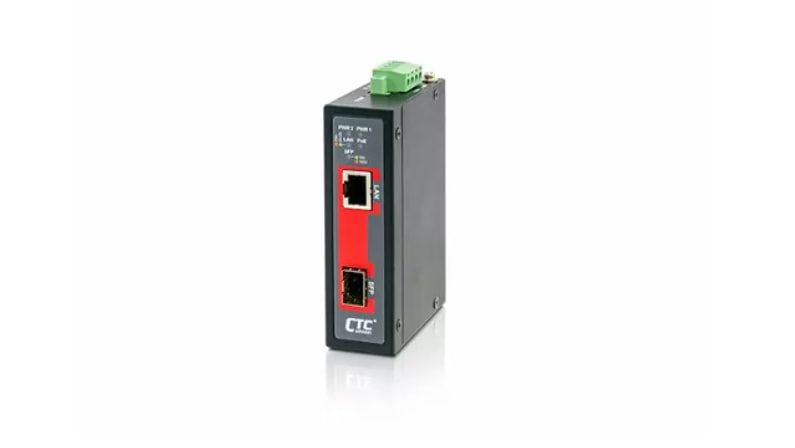
IMC-1000WS-PB: Advanced Features
Remote Management: The IMC-1000WS-PB supports two methods for remote management:
- Web-based Management: This allows for configuration and monitoring of the media converter through a web interface accessible from any standard web browser. This eliminates the need for physical access to the device for configuration changes or troubleshooting.
- SNMP Management: The device supports SNMP, a widely used network management protocol that allows it to be integrated into network management systems (NMS) for centralized monitoring and management alongside other network devices.
Configuration Options:
The IMC-1000WS-PB offers various configuration options through its web interface or SNMP management, including:
- Speed and Duplex Mode: Configure the operating speed (10 or 100 Mbps) and duplex mode (full or half duplex) for both the copper and fiber optic ports.
- Flow Control: Enable or disable flow control mechanisms to manage data flow and prevent buffer overflow on connected devices.
- Link Aggregation (optional): Some models of the IMC-1000WS-PB may support link aggregation, which combines multiple physical ports into a single logical link for increased bandwidth and redundancy.
Layer 2 Switching:
While the primary function of the IMC-1000WS-PB is media conversion, some models may offer basic Layer 2 switching functionalities. This allows the device to learn and forward MAC addresses of connected devices, improving network efficiency and reducing broadcast traffic.
Redundancy and Reliability:
The IMC-1000WS-PB offers several features that enhance network reliability and redundancy:
- Auto-MDI/MDIX: This feature automatically detects the cable type (straight-through or crossover) connected to each port, eliminating the need for dedicated crossover cables and simplifying installation.
- Dual Power Inputs: The device accepts power from two independent sources (redundant power supplies), ensuring continued operation even if one power source fails.
Security:
The IMC-1000WS-PB provides basic security features to protect the device and network:
- Password Protection: Configure a password to restrict unauthorized access to the web interface and SNMP management features.
- SNMP Community Strings: Use community strings to define different access levels for read-only and read-write operations within SNMP management.
Environmental Monitoring:
The IMC-1000WS-PB offers some environmental monitoring capabilities:
- Temperature Monitoring: The device can monitor its internal temperature and raise alarms if it exceeds predefined thresholds.
- Voltage Monitoring: It can also monitor its power supply voltage and notify of any abnormalities.
It's important to note that the specific features and functionalities may vary depending on the exact model of the IMC-1000WS-PB. Always refer to the device's user manual or datasheet for the most accurate information.
The third example of a managed media converter is the " 10/100/1000BASE-T to 1000BASE-X Smart Media Converter"
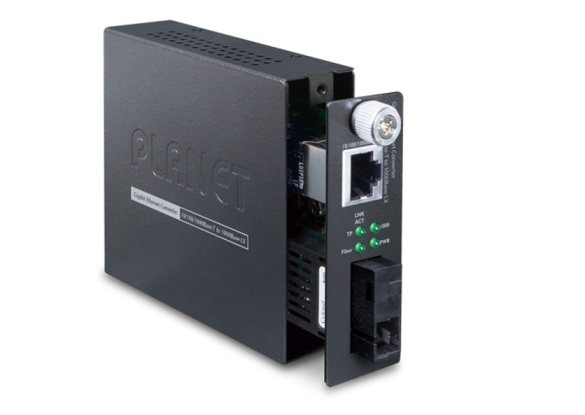
Remote Management:
- Web-based or SNMP management interface: This allows for remote configuration and monitoring of the converter's settings and status through a web browser or SNMP management software.
Configuration Options:
- Speed and duplex mode: Configure the operating speed (10/100/1000 Mbps) and duplex mode (full or half duplex) for both the copper (10/100/1000BASE-T) and fiber optic (1000BASE-X) ports.
- Flow control: Enable or disable flow control mechanisms to manage data flow and prevent buffer overflow on connected devices.
- Link aggregation (on some models): Combine multiple physical ports into a single logical link for increased bandwidth and redundancy.
- VLAN support (on some models): Divide the network into logical segments to improve security and performance.
- Quality of Service (QoS) settings (on some models): Prioritize network traffic based on specific criteria like application type or data sensitivity.
Layer 2 Switching (on some models):
- Learn and forward MAC addresses of connected devices, improving network efficiency and reducing broadcast traffic.
Configuration Options:
- Auto-MDI/MDIX: Automatically detects the cable type (straight-through or crossover) connected to each port, simplifying installation.
- Dual power inputs (on some models): Accept power from two independent sources for redundancy, ensuring continued operation even if one power supply fails.
Security:
- Password protection: Restrict unauthorized access to the web interface and SNMP management features.
- SNMP community strings: Define different access levels (read-only or read-write) for SNMP management.
- Secure protocols (on some models): May support secure protocols like SSH for encrypted communication during remote management.
Environmental Monitoring (on some models):
- Temperature monitoring: Monitor internal temperature and raise alarms if exceeding thresholds.
- Voltage monitoring: Monitor power supply voltage and notify of any abnormalities.
Important Note:
- The specific features may vary depending on the exact model of the 10/100/1000BASE-T to 1000BASE-X smart media converter. Always refer to the device's user manual or datasheet for the most accurate information on its functionalities and limitations.
Сomparison of media converters:
In comparing managed and unmanaged media converters, key factors to consider include flexibility, cost, and ease of management. Managed converters offer greater flexibility and customization options, allowing for tailored configuration to meet specific network requirements. They are well-suited for environments wh ere proactive monitoring and control are necessary to ensure optimal performance and reliability. On the other hand, unmanaged converters provide a simpler and more cost-effective solution for basic connectivity needs, making them suitable for smaller networks or deployments wh ere extensive management capabilities are not required.
Conclusion:
In conclusion, both managed and unmanaged media converters serve essential roles in modern networking, each offering distinct advantages depending on the specific requirements of the network environment. While managed converters provide enhanced features and flexibility, unmanaged converters offer simplicity and affordability. Understanding the differences between these variants allows network administrators to make informed decisions when selecting the most suitable solution for their applications, ultimately contributing to efficient and reliable network operations.

